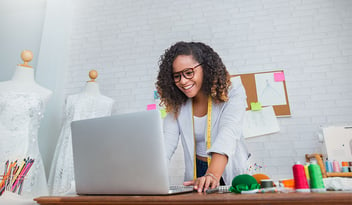4 Things Your Website Needs To Pass The Grunt Test
If you’re familiar with StoryBrand by Donald Miller, chances are, you’re familiar with the grunt test. After all, passing the grunt test is pretty much the whole point of clarifying your message.
If you have never heard of the term before, it refers to the fact that website visitors have an extremely limited attention span (8 seconds, to be exact). So, when they go to your site, they should clearly understand what your business does by quickly skimming the page.
Basically: if a caveman can grunt out what you do after 10 seconds on your website, you’re all set.
It makes perfect sense. After all, 79% of people skim website content instead of reading it word for word. We’re all busy, and we want to respect our customers’ busy lives just as much as our own.
And nothing is more frustrating than a confusing webpage.
But while it’s easy to understand the thinking behind passing the grunt test, executing it is a different story. How can you make sure your website catches your audience’s attention and clearly portrays what your business does?
Want To Get Started On Your Business Website Now?
GrowthStack CRM's easy-to-use drag-and-drop editor makes building landing pages and entire websites easy. Browse through a collection of proven templates so you won't start from scratch!

Four Copywriter-Approved Tips to ensure your Website Passes the Grunt Test Every Time:

1. Write a clear tagline.
Your tagline is the first thing your audience sees when they come to your website. It’s your first impression on your customers. The first chance you get to win them over. And that makes it one of the most (if not the most) important parts of your home page.
A strong tagline should be crystal clear. It should tell your customers either 1) what you do, or 2) how you help improve their lives.
Yet many people create abstract, vague taglines that don’t make any sense on their own. It may sound pretty. It may look good on a postcard. But if it doesn’t summarize who you are or how you can help transform your customers’ lives, it’s doing more harm than good.
Here’s an example.
“Let’s Make Healthy Happen.”
What do you think this business sells? Are they an herbal supplement brand? A nutritionist? A surgical center?
It could be anything. And if the business name didn’t give it away, we might still be scratching our heads.
This tagline from Anytime Fitness is inspirational and upbeat. For the purpose of a tagline, however, it just misses the mark. You have to scroll past the tagline and read more into the text to find out what the business does and how it could help you. And many visitors won’t be willing to do that.
If Anytime Fitness took their tagline and changed it to: “A Place Where You Can Become the Healthiest You” or “Healthy Is Just a Membership Away”, they could capture the same theme of their original tagline while emphasizing to their audience what they do and why they’re the best option.
2. Choose a hero image that tells it all.
Most people are visual learners. So, when they come to your website, they aren’t reading the copy. They’re looking at the images. And the most important image they’re considering is your hero image.
The hero image (or header image) is the top imagery on the website, usually behind the tagline. Ideally, your hero image should be aspirational. Visitors should see the photo and think, “That’s it! That’s what I want to be!” If you do that, they have already bought into your copy—without reading a thing.
A big mistake a lot of business owners make when creating a home page is choosing a photo of themselves (or their building) as the hero image. You might be thinking to yourself, “Wait a minute, I thought we wanted people to figure out who we are within 8 seconds. What better way to do that than to include a photo of ourselves?”
Well, not only does this go against the StoryBrand Methodology, but it also creates a website that feels cold.
Here’s what I mean. These are header images from two competing surgical hospitals in Oklahoma City. 

They offer similar services and both have solid reputations in the area. But the header images create very different experiences. The top image makes you think of words like, “Comforting,” “Empathetic,” “Caring,” and “Safe”. It’s the kind of hospital you’d want to go to because you know they’ll take care of you. They’re people-oriented, and they’re all about you.
The second image might provide some authority, but it lacks all the emotional aspects of the first image. It tells you nothing about the heart of the business: who they are, what they do, or how they’ll treat you. It’s sad because, in all actuality, the second site has a stronger tagline. But most people won’t even read it.
If you had to pick, which would you choose?
That’s the power of relevant aspirational imagery. You can’t pass the grunt test without it!
3. Creating an engaging one-liner.
In most StoryBranded websites, the one-liner (aka elevator pitch) will be the first main paragraph after your tagline. So, if you can hook visitors enough to actually read the page, it’s a pretty important piece. It’s also one of the most challenging parts of the BrandScript.
Many people try to put too much into their one-liner. They want to tell their whole story, to include all of their biggest authority pieces, and to go in detail about how they help. But, while all of that might be important to you, your customers won’t be invested enough to care.
You need to let them get to know you better before you talk in-depth about yourself. Give them a reason to care about what makes you unique. To do that, your one-liner needs to be all about your customer, only including your business as a way to help them succeed.
A good one-liner will follow this formula:
- Start by highlighting a problem your customers experience.
- Introduce your company as the guide and touch on how you help.
- Tease how much better their life will look after they choose your business.
It should only be a couple of sentences long. As a good rule of thumb, try reading your one-liner to someone outside of your business and see how it makes them feel. Do they want to learn more? Do they clearly understand why they might need your business?
If so, it’s sure to pass the grunt test!
4. Use icons and bullets to highlight important info.
When you scan a website, you typically notice three things: the photos, the main headings, and text that stands out. So if you have the first two down, it’s time to master the third!
Icons, checkmarks, and bullet points are great graphical elements you can use to bring attention to important points in your copy. Some good pieces to highlight can include:
- Your services (if you offer several)
- Top benefits of your product or service
- The Agreement Plan section (what sets you apart from other competitors)
![]()
![]()
Another good idea is to bold key phrases and calls to action. Just be careful not to over-do it. If too much is emphasized, nothing will be.
Ace the grunt test with ROI Online
Passing the grunt test is key to winning over potential customers. You can have the most beautiful site in the world, but if it fails to pass the grunt test, you won’t receive any return from your investment.
Let us set your business up for success!
At ROI Online, we have helped dozens of entrepreneurs clarify their message, iron out their story, and create stunning websites that resonate with potential customers.
Download our QuickStart Plan and see how it works!
A Website Is Just Part Of An Entire Marketing System
We created GrowthStack CRM to bring you a set of tools that go beyond the company website. You can set up Workflows to automate almost anything, get started on Two-Way Text Messaging to close more sales faster, manage Reviews & Reputation, and so much more!
All the tools inside GrowthStack CRM work together to help you streamline your marketing efforts, all on autopilot!




